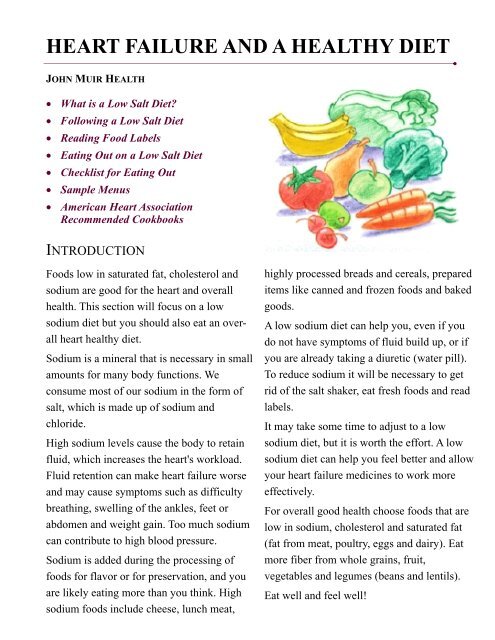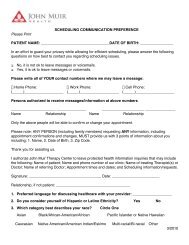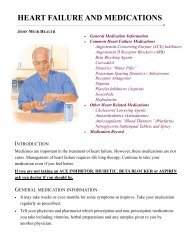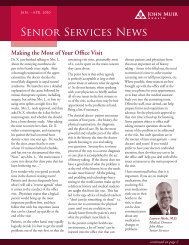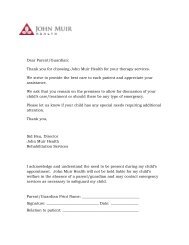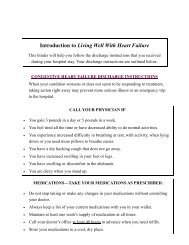Heart Failure and a Healthy Diet - John Muir Health
Heart Failure and a Healthy Diet - John Muir Health
Heart Failure and a Healthy Diet - John Muir Health
Create successful ePaper yourself
Turn your PDF publications into a flip-book with our unique Google optimized e-Paper software.
HEART FAILURE AND A HEALTHY DIET<br />
JOHN MUIR HEALTH<br />
• What is a Low Salt <strong>Diet</strong>?<br />
• Following a Low Salt <strong>Diet</strong><br />
• Reading Food Labels<br />
• Eating Out on a Low Salt <strong>Diet</strong><br />
• Checklist for Eating Out<br />
• Sample Menus<br />
• American <strong>Heart</strong> Association<br />
Recommended Cookbooks<br />
INTRODUCTION<br />
Foods low in saturated fat, cholesterol <strong>and</strong><br />
sodium are good for the heart <strong>and</strong> overall<br />
health. This section will focus on a low<br />
sodium diet but you should also eat an overall<br />
heart healthy diet.<br />
Sodium is a mineral that is necessary in small<br />
amounts for many body functions. We<br />
consume most of our sodium in the form of<br />
salt, which is made up of sodium <strong>and</strong><br />
chloride.<br />
High sodium levels cause the body to retain<br />
fluid, which increases the heart's workload.<br />
Fluid retention can make heart failure worse<br />
<strong>and</strong> may cause symptoms such as difficulty<br />
breathing, swelling of the ankles, feet or<br />
abdomen <strong>and</strong> weight gain. Too much sodium<br />
can contribute to high blood pressure.<br />
Sodium is added during the processing of<br />
foods for flavor or for preservation, <strong>and</strong> you<br />
are likely eating more than you think. High<br />
sodium foods include cheese, lunch meat,<br />
highly processed breads <strong>and</strong> cereals, prepared<br />
items like canned <strong>and</strong> frozen foods <strong>and</strong> baked<br />
goods.<br />
A low sodium diet can help you, even if you<br />
do not have symptoms of fluid build up, or if<br />
you are already taking a diuretic (water pill).<br />
To reduce sodium it will be necessary to get<br />
rid of the salt shaker, eat fresh foods <strong>and</strong> read<br />
labels.<br />
It may take some time to adjust to a low<br />
sodium diet, but it is worth the effort. A low<br />
sodium diet can help you feel better <strong>and</strong> allow<br />
your heart failure medicines to work more<br />
effectively.<br />
For overall good health choose foods that are<br />
low in sodium, cholesterol <strong>and</strong> saturated fat<br />
(fat from meat, poultry, eggs <strong>and</strong> dairy). Eat<br />
more fiber from whole grains, fruit,<br />
vegetables <strong>and</strong> legumes (beans <strong>and</strong> lentils).<br />
Eat well <strong>and</strong> feel well!
Page 16<br />
HEART FAILURE AND A HEALTHY DIET<br />
WHAT IS A LOW SALT DIET?<br />
• One teaspoon of table salt has 2,400 mg (2.4 grams) of sodium. This is more than any one<br />
person should have each day.<br />
• The recommendation for the average American is to eat 2,300 mg or less of sodium each<br />
day.<br />
• People with mild heart failure (no or mild symptoms with vigorous or moderate exercise)<br />
are usually asked to limit their sodium intake to 2,300 mg per day.<br />
• People with moderate to severe heart failure (symptoms with light exercise, household<br />
chores or at rest) are usually asked to limit their sodium intake to 2,000 mg per day.<br />
• Check with your doctor or nurse for the sodium limit that is best for you.<br />
• DO NOT use potassium-based salt substitutes without consulting your doctor. If you aren’t<br />
sure, check the label or ingredient list for “potassium” or “potassium chloride”.<br />
FOLLOWING A LOW SALT DIET<br />
There are four basic steps to following a low salt diet:<br />
1. Stop adding salt to your food <strong>and</strong> ask if food can be<br />
prepared without salt if dining out.<br />
2. Adapt your preferred foods to a low sodium version.<br />
3. Pick foods naturally low in sodium.<br />
4. Read food labels.<br />
STOP ADDING SALT TO YOUR FOOD<br />
You can decrease your sodium intake by<br />
as much as 30 percent by doing two<br />
simple things:<br />
• Take the salt shaker off the table.<br />
• Do not add any salt of any type when<br />
cooking.
Page 17<br />
HEART FAILURE AND A HEALTHY DIET<br />
Food doesn’t have to taste bl<strong>and</strong> without salt! Try these tips to make foods taste great without<br />
adding salt:<br />
• Experiment with sodium free herbs, spices <strong>and</strong> seasoning mixes.<br />
• Try using seasonings like black, cayenne or lemon pepper.<br />
• Dried <strong>and</strong> fresh herbs such as garlic, garlic or onion powder (not salt), dill, parsley <strong>and</strong><br />
rosemary are also naturally low in sodium. Combination spice mixes in a bottle are great<br />
as long as sodium or salt is not one of the ingredients.<br />
• Use balsamic or other vinegars to flavor foods or marinate meats.<br />
• Sprinkle fresh lemon juice over vegetables <strong>and</strong> salads.<br />
• Season or marinate meat, poultry <strong>and</strong> fish ahead of time with onion, garlic, vinegar, wine<br />
<strong>and</strong> your favorite herbs before cooking to bring out the flavor.<br />
• Avoid spices <strong>and</strong> seasoning mixes with the word salt or sodium in the name. They will be<br />
high in sodium. For example, just a teaspoon of a seasoned salt such as garlic salt or<br />
celery salt contains about 1,500 mg of sodium.<br />
• There are many salt free seasoning mixes in your supermarket. Look in the spice section<br />
for seasonings labeled “salt free”.<br />
• Avoid salt substitutes made with potassium (such as NuSalt, Also Salt, Morton Lite Salt).<br />
ADAPT YOUR PREFERRED FOODS TO A LOW SODIUM VERSION<br />
Consider getting a low salt cookbook. You can find<br />
excellent low salt cookbooks at your local library. You<br />
can also buy one at a bookstore or on the Internet.<br />
After getting used to low sodium eating, you will be<br />
able to adapt your favorite recipes to low sodium<br />
versions.<br />
For example, if you like soup, make your own low<br />
sodium version with fresh meat <strong>and</strong> vegetables. Toss<br />
the ingredients into a slow cooker <strong>and</strong> use herbs <strong>and</strong><br />
spices for seasonings. Make extra <strong>and</strong> freeze some for<br />
later meals.
Page 18<br />
HEART FAILURE AND A HEALTHY DIET<br />
Use low sodium substitutes<br />
For example, prepare a fresh lean pork roast instead of a country ham. You can cook fresh<br />
chicken, turkey, roast beef or pork without adding salt <strong>and</strong> use the meats for s<strong>and</strong>wiches<br />
instead of packaged lunch meats. Use fresh lettuce, tomato <strong>and</strong> onion for flavoring.<br />
EXAMPLES OF HIGH SODIUM FOODS AND LOW SODIUM ALTERNATIVES<br />
Baking powder (1 tsp.)<br />
400–550 mg<br />
Salted nuts (1 oz.)<br />
120–250 mg<br />
Low sodium baking powder (1 tsp.)<br />
5 mg<br />
Unsalted nuts (1 oz.)<br />
3–10 mg<br />
Garlic salt (1 tsp.)<br />
1,480 mg<br />
Saltine crackers (1 cracker)<br />
70 mg<br />
Garlic powder (1 tsp.)<br />
1 mg<br />
Low sodium saltine crackers (1 cracker) 7 mg<br />
Peanut butter (2 tbsp.)<br />
150–250 mg<br />
Self-rising flour (1 cup)<br />
1,600 mg<br />
Unsalted peanut butter (2 tbsp.)<br />
0 mg<br />
Enriched white flour (1 cup)<br />
3–6 mg<br />
Canned pasta sauce (1/4 cup)<br />
25–275 mg<br />
Ham (3 oz.)<br />
1,025 mg<br />
No salt added pasta sauce (1/4 cup)<br />
25 mg<br />
Fresh pork (3 oz.)<br />
60 mg<br />
French fries (small order)<br />
150-700 mg<br />
Instant oatmeal (3/4 cup)<br />
180 mg<br />
Unsalted French fries<br />
10–20 mg<br />
Regular cooking oatmeal (3/4 cup)<br />
5 mg<br />
Corned beef (3 oz.)<br />
800 mg<br />
Turkey ham (3 oz.)<br />
865 mg<br />
Roast beef (3 oz.)<br />
60 mg<br />
Turkey (3 oz.)<br />
75 mg<br />
Look for low sodium versions<br />
Many types of canned goods are now available in low sodium<br />
versions. Look for canned foods labeled sodium free, no salt,<br />
low sodium, light in sodium, very low sodium, reduced sodium<br />
or unsalted. These are good eye catching words but be sure that<br />
you still read the food label.<br />
You can also remove some sodium from canned foods by<br />
rinsing them, soaking them <strong>and</strong> rinsing them again. Keep in<br />
mind that this does not remove all of the sodium.
Page 19<br />
HEART FAILURE AND A HEALTHY DIET<br />
READING FOOD LABELS<br />
Reading the food label is a big step toward eating for a healthier heart. Food labels tell<br />
you what’s contained within the foods you eat. Comparing labels will help you make<br />
food choices that are low in sodium (salt), fat <strong>and</strong> cholesterol but high in fiber. To get<br />
started, look for the “Nutrition Facts” label on packaged foods.<br />
Serving Size<br />
Look at this closely. This is the amount of<br />
food in 1 serving. If you eat more, you get<br />
more of everything on the label—including<br />
salt, fat <strong>and</strong> calories.<br />
Servings Per Container<br />
There is often more than 1 serving per<br />
container of food, even if the container is<br />
small. For the label shown here, if you eat the<br />
full container, you are eating two times the<br />
serving size (280 mg of sodium).<br />
Total Fat<br />
This number tells you how many grams (g) of<br />
fat are in 1 serving. Choose foods with a low<br />
number for total fat.<br />
Saturated Fat<br />
This number tells you how many grams (g) of<br />
saturated fat are in 1 serving. Look for foods<br />
that have little or no saturated fat.<br />
Trans Fat<br />
This number tells you how much trans fat is<br />
in 1 serving. Choose foods that have little or<br />
no trans fat.<br />
Cholesterol<br />
This number tells you how much cholesterol<br />
is in 1 serving. You should eat less than 300<br />
milligrams (mg) of cholesterol a day.<br />
Sodium<br />
This number tells you how much sodium is<br />
in 1 serving. Choose foods with low numbers<br />
for sodium or look for foods that say Low<br />
Sodium or Sodium Free. An entire meal<br />
should contain 700 mg or less of sodium.
Page 20<br />
HEART FAILURE AND A HEALTHY DIET<br />
PICK FOODS NATURALLY LOW IN SODIUM<br />
Choose fresh foods<br />
Fresh fruits <strong>and</strong> vegetables have very little sodium. The same is true for fresh meat,<br />
poultry <strong>and</strong> fish. Generally, you don’t have to count the sodium content when eating fresh,<br />
unprocessed foods. So, think fresh when choosing foods.<br />
If you are not eating fresh foods, choose low sodium foods as much as possible. Good<br />
options include canned fruit <strong>and</strong> plain frozen vegetables. Dried beans, peas, rice <strong>and</strong><br />
lentils are also excellent low sodium foods. Make sure not to add salt or other ingredients<br />
such as salt pork or bouillon when cooking them. Keep a list of low sodium, heart healthy<br />
foods that you like <strong>and</strong> bring it with you to the store. The more detailed the list, the less<br />
time you have to spend reading labels each shopping trip.<br />
LOW SODIUM FOODS<br />
Foods with less than 10 mg of sodium per serving<br />
• Fruit <strong>and</strong> fruit juices (fresh, frozen or canned)<br />
• Honey, sugar<br />
• Hot cereals such as oatmeal, wheat <strong>and</strong> oat bran (regular cooking, not instant which is<br />
high in sodium, 1 cup with no salt added while cooking)<br />
• Jelly beans (10 large)<br />
• Macaroni, noodles, rice <strong>and</strong> barley (1 cup cooked in unsalted water with no added salt)<br />
• Salt free herbs <strong>and</strong> spices<br />
• Shredded wheat or puffed rice cereals (1 cup)<br />
• Unsalted nuts<br />
• Unsalted peanut butter (but not regular peanut butter)<br />
• Unsalted butter or margarine (but not regular)<br />
• Unsalted cottage cheese (1/2 cup)<br />
• Vegetables (most types fresh or frozen except those in<br />
the 10–40 mg section, see next page)<br />
• Vinegar
Page 21<br />
HEART FAILURE AND A HEALTHY DIET<br />
Foods with 10–40 mg of sodium<br />
per serving<br />
• Beets (1/2 cup)<br />
• Beet greens (1/3 cup)<br />
• Carrots (1 cup)<br />
• Celery (2 stalks)<br />
• Club soda (8 oz.)<br />
• Granola cereal (1/2 cup)<br />
• Kale (3/4 cup)<br />
• Soda pop (8 oz.)<br />
• Spinach (1/2 cup cooked)<br />
• Vanilla wafers (2 cookies)<br />
• White wine (4 oz.)<br />
Foods with 40–65 mg of sodium<br />
per serving<br />
• Beef, pork, lamb <strong>and</strong> poultry (fresh, 3 oz.)<br />
• Corn tortilla (1, 6 inch)<br />
• Egg (1)<br />
• Fish (fresh, 3 oz.)<br />
• Fruit-filled cookies (1, small)<br />
• Shrimp (2 oz.)<br />
Foods with 65–120 mg of sodium<br />
per serving<br />
• Clams, steamed (3 oz.)<br />
• Ice cream (1/2 cup)<br />
• Mayonnaise (1 tbsp.)<br />
Initially it may take longer to shop. As you<br />
become familiar with low sodium food<br />
choices shopping will be easier.<br />
• Milk (evaporated,1/2 cup)<br />
• Milk (whole or skim, 1 cup)<br />
• Mustard, chili <strong>and</strong> hot sauce (1 tsp.)<br />
• Yogurt (1 cup)<br />
Foods with 120–175 mg of sodium<br />
per serving<br />
• Bread (some types, 1 slice)<br />
• Chocolate covered peanut butter cups (2)<br />
• English muffin (1/2)<br />
• Ketchup <strong>and</strong> steak sauce (1 tsp.)<br />
• Olives (ripe, 5)<br />
• Sardines (1 large)<br />
• Peanut butter (regular, 2 tbsp.)
Page 22<br />
HEART FAILURE AND A HEALTHY DIET<br />
Use herbs <strong>and</strong> spices<br />
Herbs <strong>and</strong> spices add flavor to cooking without adding fat or sodium. That’s why they’re great<br />
for healthy cooking. Try these tips to help create tasty, healthy meals.<br />
• Use a sharp knife to cut fresh herbs. Cutting the leaves finely will release the most flavor.<br />
• Don’t grind whole spices until you need them. Crushing or grating whole spices just before<br />
adding them to a recipe will guarantee the most flavor.<br />
• Dried herbs pack more flavor for the same quantity of<br />
fresh herbs. Powdered herbs are more potent than dried<br />
flakes. If you are using powdered herbs in a recipe that calls<br />
for fresh, decrease the amount you add.<br />
• When adding herbs to cold recipes, such as dips or salad<br />
dressings, allow the food to sit in the refrigerator for a couple<br />
of hours before serving so the flavors can blend.<br />
• Add fresh herbs to hot dishes as close to serving time as<br />
possible for the most flavorful results. Dried herbs <strong>and</strong> spices should be added early in the<br />
cooking process to prevent a powdery taste.<br />
• Store dried herbs in a cool, dry, dark place. Keep dried herbs for no longer than a year.<br />
• Experiment with different herbs <strong>and</strong> spices. Try these vegetable <strong>and</strong> herb combinations:<br />
• Asparagus with garlic, lemon juice, mustard seed, onion, sesame seed, tarragon<br />
• Snap peas with basil, dill, lemon, marjoram, mint, nutmeg, oregano, tarragon<br />
• Beets with allspice, bay leaves, caraway seed, cloves, dill, ginger, mustard seed, thyme<br />
• Broccoli with caraway seeds, dill, mustard seed, tarragon<br />
• Cabbage with caraway seed, celery seed, dill, mint, mustard seed, nutmeg, tarragon<br />
• Carrots with allspice, bay leaves, caraway seed, dill, fennel, ginger, mace, marjoram<br />
• Corn with cayenne (red pepper), chili powder<br />
• Cucumbers with basil, chives, dill, garlic, mint, tarragon, vinegar<br />
• Green salads with basil, chives, dill, tarragon<br />
• Peas with basil, marjoram, mint, oregano, parsley, poppy seed, rosemary<br />
• Potatoes with basil, bay leaves, celery seeds, chives, dill, mustard seed, oregano, thyme<br />
• Squash with allspice, basil, cinnamon, cloves, ginger, mustard seed, nutmeg, rosemary
Page 23<br />
HEART FAILURE AND A HEALTHY DIET<br />
EATING OUT ON A LOW SALT DIET<br />
Many people go out to eat several times each week. Eating out, whether it is at a restaurant, a<br />
friend’s house or a party, can be challenging if you are on a low sodium diet. You can go out<br />
to eat <strong>and</strong> maintain a low sodium diet, if you are careful.<br />
Use the following tips while eating out:<br />
• Choose restaurants that offer fresh food choices.<br />
• Be specific about what you want <strong>and</strong> how you want it prepared when ordering. For<br />
example, ask that your food be prepared without added salt, monosodium glutamate<br />
(MSG) or soy sauce.<br />
• Do not be afraid to question your waiter about how the food is prepared.<br />
• Choose foods without sauces or ask for sauces <strong>and</strong> salad dressings “on the side”.<br />
• If you use salad dressing, dip the tines of your fork into the dressing cup <strong>and</strong> then pierce<br />
your food, instead of pouring the dressing over your food. That way you get the flavor<br />
without all the sodium.<br />
• Use the same technique<br />
with other types of sauces<br />
such as barbecue, steak,<br />
creamed, cheesy,<br />
Holl<strong>and</strong>aise, Alfredo or red<br />
spaghetti sauces. It also<br />
works with gravies.<br />
• Limit use of condiments<br />
that are high in sodium such<br />
as Worcestershire sauce,<br />
steak sauce or ketchup.<br />
• Avoid dishes named au gratin, Parmesan, hashed, Newberg, casserole <strong>and</strong> Devonshire.<br />
• Be careful of foods that are labeled as good for your heart. These foods are usually low<br />
fat, but they may be high in sodium. In many cases, salt is used to flavor low fat foods.<br />
• Choose the salad bar. It can be an excellent way to eat a low sodium meal in a restaurant.
Page 24<br />
HEART FAILURE AND A HEALTHY DIET<br />
• Choose fresh vegetables, fruits <strong>and</strong> eggs served in their natural state. That includes lettuce<br />
greens, spinach, tomatoes, cucumbers, onions, radishes, green peppers, red peppers,<br />
alfalfa sprouts, fresh mushrooms, broccoli, cauliflower, carrots, red cabbage <strong>and</strong> hard<br />
boiled eggs.<br />
• Avoid high sodium foods including croutons, green olives, black olives, shredded cheese,<br />
bacon bits, macaroni salad, potato salad, coleslaw, sunflower seeds, pepperoni, Chinese<br />
noodles, pickles <strong>and</strong> creamy salad dressings.<br />
• Choose the following salad dressings: oil <strong>and</strong> vinegar, lemon <strong>and</strong> flavored vinegars such<br />
as balsamic <strong>and</strong> raspberry. Avoid regular, light <strong>and</strong> fat free dressings unless you order on<br />
the side <strong>and</strong> dip your fork tines in the dressing. They are all high in sodium.<br />
ASK!<br />
ACT!<br />
Will the restaurant:<br />
• Serve fat free or 1% milk?<br />
• Trim visible fat from poultry or meat?<br />
• Leave off all butter, gravy or sauces?<br />
• Serve salad dressing on the side?<br />
• Accommodate special requests?<br />
• Use less cooking oil?<br />
• Prepare a dish using canola or olive oil?<br />
Select foods that are:<br />
• Steamed<br />
• Garden fresh<br />
• Broiled<br />
• Baked<br />
• Roasted<br />
• Poached<br />
• Lightly sautéed or stir-fried<br />
• Use trans fat free margarines?<br />
• Serve fruit, ices, sherbet or other low fat<br />
desserts?<br />
• Take special food preparation requests?<br />
• Prepare food without MSG or salt?<br />
• Broil, bake, steam or poach rather than<br />
fry foods?
Page 25<br />
HEART FAILURE AND A HEALTHY DIET<br />
CHECKLIST FOR EATING OUT<br />
• Don't be shy or intimidated about making special requests.<br />
• If your food is not prepared as you requested, send it back.<br />
• Most foods will fit in a heart healthy diet if prepared low fat<br />
<strong>and</strong> with less salt.<br />
• Watch portion sizes, split your food with a friend or take<br />
some home.<br />
Type of<br />
Restaurant<br />
Foods to Choose<br />
Foods to Avoid<br />
Asian Food • Menu items that are made to<br />
order <strong>and</strong> include a variety of<br />
vegetables<br />
• Food prepared without salt, soy<br />
sauce or MSG<br />
• Deep fried egg rolls, wontons,<br />
tofu, meats <strong>and</strong> noodles<br />
• Curry sauces <strong>and</strong> gravies<br />
• Fried rice<br />
• Spring rolls that are not deep<br />
fried<br />
• Steamed rice instead of fried<br />
rice<br />
• Entrees with vegetables <strong>and</strong> lean<br />
meat, chicken, fish or tofu<br />
Italian Food • Items that are fixed to order<br />
• Order sauces on the side<br />
• Items with tomato or red clam<br />
sauce<br />
Salad Bars • Whole grain breads <strong>and</strong> other<br />
grain products<br />
• Tofu, legumes<br />
• Fresh fruits <strong>and</strong> vegetables<br />
• Items in heavy cream sauces<br />
(such as Alfredo)<br />
• Cheese<br />
• Breaded or fried foods<br />
• Bacon bits, pickles, salted<br />
sunflower seeds<br />
• Meat salads (such as tuna or<br />
chicken salads)<br />
• Cheese
Page 26<br />
HEART FAILURE AND A HEALTHY DIET<br />
Type of Restaurant Foods to Choose Foods to Avoid<br />
Fast Food • Pre-packaged salad with low fat<br />
salad dressing<br />
• S<strong>and</strong>wiches without pickles,<br />
mayonnaise, cheese or special<br />
sauces<br />
• Roasted or broiled meat<br />
s<strong>and</strong>wiches<br />
• Submarine s<strong>and</strong>wiches with lean<br />
meats <strong>and</strong> lots of vegetables<br />
Family Style Food • Grilled or baked chicken or fish<br />
• Baked potatoes (without butter<br />
or sour cream)<br />
• Steamed vegetables <strong>and</strong> tossed<br />
salads with low fat dressing<br />
• A side salad instead of French<br />
fries or chips<br />
• Low fat or nonfat yogurt or<br />
sherbet for dessert<br />
Mexican Food • Dishes with a variety of<br />
vegetables <strong>and</strong> very little cheese<br />
• Beans, rice, corn or flour<br />
tortillas, lean meat <strong>and</strong> chicken<br />
items (such as fajitas <strong>and</strong> chile<br />
verde)<br />
Breakfast Food • Fresh fruit<br />
• Whole grain toast <strong>and</strong> cereals<br />
• Fat free or low fat yogurt<br />
• Eggs dishes made with egg<br />
substitute or egg whites<br />
• Breaded chicken, fried fish,<br />
onion rings <strong>and</strong> French fries<br />
• Cheese, bacon <strong>and</strong> large serving<br />
of hamburger<br />
• Malts or milkshakes<br />
• High salt items such as cured<br />
meats (ham, salami, etc), olives,<br />
pickles <strong>and</strong> dressings<br />
• Dishes with lots of cheese, sour<br />
cream or cream sauces (such as<br />
Holl<strong>and</strong>aise or Alfredo)<br />
• Fried fish or chicken<br />
• Dishes that are smothered, fried,<br />
breaded or creamy<br />
• Appetizer-type foods, au gratin<br />
potatoes, prime rib, cream soups<br />
<strong>and</strong> milkshakes<br />
• Deep fried tortilla chips <strong>and</strong> taco<br />
shells<br />
• Cheese or sour cream<br />
• Cheese <strong>and</strong> butter<br />
• Creamy sauces<br />
• Bacon<br />
• Ham<br />
• Sausage
Page 27<br />
HEART FAILURE AND A HEALTHY DIET<br />
SAMPLE LOW SODIUM MENUS<br />
Day 1—1,500 calories<br />
2,300 mg Sodium Menu Sodium Substitution To Reduce Sodium Sodium<br />
mg to 1,500 mg mg<br />
BREAKFAST 302 Calories, 348 mg Sodium<br />
3/4 cup bran flakes 220 3/4 cup shredded wheat cereal 1<br />
1/2 banana 1<br />
1 cup non-fat milk 127<br />
1 whole orange 0<br />
LUNCH 499 Calories, 805 mg Sodium<br />
Chicken Breast S<strong>and</strong>wich<br />
3 oz grilled or broiled 120<br />
2 slices whole wheat bread 299<br />
1 Tbsp Dijon mustard 373 1 Tbsp regular mustard 175<br />
1/4 whole mashed avocado 5<br />
1/2 cup fresh cucumber slice 1<br />
2 tomato slices 2<br />
1/2 cup fruit cocktail, juice pack 5<br />
DINNER 440 Calories, 379 mg Sodium<br />
3 oz cod: 70<br />
1 tsp lemon juice 1<br />
1/2 cup brown rice 5<br />
1 cup spinach, cooked from frozen,<br />
sauteed with 1 tsp canola oil: 184<br />
1 small cornbread muffin, made with oil: 119<br />
SNACK 288 Calories, 153 mg Sodium<br />
1/2 cup fruit yogurt, fat free, no sugar added 75<br />
1/4 cup almonds, unsalted 0<br />
1 lg graham cracker rectangle 78<br />
Total Calories 1529 1529<br />
Total Milligrams of Sodium 1685 1268
Page 28<br />
HEART FAILURE AND A HEALTHY DIET<br />
Day 2—1,500 calories<br />
2,300 mg Sodium Menu Sodium Substitution To Reduce Sodium Sodium<br />
mg to 1,500 mg mg<br />
BREAKFAST 356 Calories, 285 mg Sodium<br />
1 low-fat granola bar 81<br />
1/2 banana 1<br />
1/2 cup fruit yogurt, fat-free, no sugar added 75<br />
1 cup non-fat milk 127<br />
1 cup fresh strawberries 1<br />
LUNCH 528 Calories, 812 mg Sodium<br />
1 turkey breast s<strong>and</strong>wich:<br />
3 oz turkey breast 48<br />
2 slices whole wheat bread 299<br />
1 large leaf romaine lettuce 1<br />
2 slices tomato 2<br />
1/4 whole avocado, mashed 5<br />
1 Tbsp Dijon mustard 373 Omit mustard 0<br />
1 cup carrot sticks 84<br />
1 medium apple 0<br />
DINNER 404 Calories, 623 mg Sodium<br />
1 cup spaghetti (try multi grain): 1<br />
3/4 cup vegetarian sauce* 479 Use low-sodium tomato paste<br />
(6 oz) in recipe 253<br />
1 Tbsp Parmesan cheese 93<br />
Spinach salad<br />
*recipes on following page<br />
1 cup fresh spinach leaves 24<br />
1/4 cup fresh carrot, grated 19<br />
1/4 cup fresh mushrooms 1<br />
1 Tbsp vinaigrette dressing* 1<br />
1/2 cup canned pears 5<br />
SNACK 203 Calories, 4 mg Sodium<br />
1 oz walnuts (about 14 halves) 1<br />
1/4 cup dried apricots 3<br />
Total Calories 1541 1541<br />
Total Milligrams of Sodium 1724 1498
Page 29<br />
HEART FAILURE AND A HEALTHY DIET<br />
Vegetarian Spaghetti Sauce<br />
2 Tbsp olive oil<br />
2 small onions, chopped<br />
3 cloves garlic, chopped<br />
11/4 cups zucchini, sliced<br />
1 Tbsp oregano, dried<br />
1 Tbsp basil, dried<br />
1 8 oz can tomato sauce<br />
1 6 oz can tomato paste*<br />
2 medium tomatoes, chopped<br />
1 cup water<br />
1. In a medium skillet, heat oil. Sauté onions, garlic <strong>and</strong> zucchini in oil for 5 minutes on<br />
medium heat.<br />
2. Add remaining ingredients <strong>and</strong> simmer covered for 45 minutes. Serve over spaghetti.<br />
Makes 6 servings. 105 calories per serving. Serving Size: 3/4 cup. *To reduce sodium, use a<br />
6 oz can of low-sodium tomato paste. New sodium content for each serving is 253 mg.<br />
Vinaigrette Salad Dressing<br />
1 bulb garlic, separated <strong>and</strong> peeled<br />
1/2 cup water<br />
1 Tbsp red wine vinegar<br />
1/4 tsp honey<br />
1 Tbsp virgin olive oil<br />
1/4 tsp black pepper<br />
1. Place the garlic cloves into a small saucepan <strong>and</strong> pour enough water (about 1/2 cup) to<br />
cover them.<br />
2. Bring water to a boil, then reduce heat <strong>and</strong> simmer until garlic is tender, about 15 minutes.<br />
3. Reduce the liquid to 2 Tbsp <strong>and</strong> increase the heat for 3 minutes.<br />
4. Pour the contents into a small sieve over a bowl, <strong>and</strong> with a wooden spoon, mash the garlic<br />
through the sieve into the bowl.<br />
5. Whisk the vinegar into the garlic mixture; incorporate the oil <strong>and</strong> seasoning.<br />
Makes 4 servings. 33 calories per serving. Serving Size: 2 Tbsp.
Page 30<br />
HEART FAILURE AND A HEALTHY DIET<br />
AMERICAN HEART ASSOCIATION RECOMMENDED COOKBOOKS<br />
From quick dinner ideas to delicious desserts, American <strong>Heart</strong> Association cookbooks provide<br />
lots of ways to make cooking healthier.<br />
• American <strong>Heart</strong> Association Low-Salt Cookbook, 3rd Edition<br />
• American <strong>Heart</strong> Association Low-Fat, Low-Cholesterol Cookbook, Third Edition<br />
• The New American <strong>Heart</strong> Association Cookbook, 7th Edition<br />
• American <strong>Heart</strong> Association One-Dish Meals<br />
• American <strong>Heart</strong> Association Low-Calorie Cookbook<br />
• American <strong>Heart</strong> Association Meals in Minutes Cookbook<br />
• American <strong>Heart</strong> Association No-Fad <strong>Diet</strong>: A Personal Plan for <strong><strong>Health</strong>y</strong> Weight Loss<br />
• Diabetes & <strong>Heart</strong> <strong><strong>Health</strong>y</strong> Cookbook<br />
• American <strong>Heart</strong> Association Quick & Easy Cookbook<br />
• American <strong>Heart</strong> Association Low-Fat & Luscious Desserts<br />
If you have questions or want more information, call the <strong>John</strong> <strong>Muir</strong> <strong>Health</strong><br />
Nutrition Services Department.<br />
Monday – Friday 8:30 AM to 5:00 PM<br />
Concord Campus — (925) 674-2518<br />
Walnut Creek Campus — (925) 947-5314


